-
Welcome to Talking Time's third iteration! If you would like to register for an account, or have already registered but have not yet been confirmed, please read the following:
- The CAPTCHA key's answer is "Percy"
- Once you've completed the registration process please email us from the email you used for registration at percyreghelper@gmail.com and include the username you used for registration
Once you have completed these steps, Moderation Staff will be able to get your account approved.
Goemon's first adventure on the SNES: Let's Play The Legend of the Mystical Ninja!
Back to Let's Play
< 1 2 >
< 1 2 >
|
#1
|
|||
|
|||
|
Goemon you say? What's that? It's Konami's series of games staring the ninja Goemon. The cast and setting all get a bit a goofy, even for Konami. As in: ninjas in ancient Japan eating hamburgers, occasionally stumbling into gameshows, and all around everyone has cartoony, slapstick reactions. If you haven't played it, Legend of the Mystical Ninja is also a real fun game. It's sidescrolling action, but you roam freely during towns in a beat 'em up style perspective before venturing out into more linear, 2D action stages with the boss.
Episode 1: https://www.youtube.com/watch?v=7D5QXZDtpTc ~ The Goemon games tend to have a very large number of cultural references, in no small part due to how the game blends both a feudal setting and a modern setting. There is an interesting webpage that goes into detail about the Japanese cultural references within the game. It's worth checking it out! I'll mention some of these during the LP, but I'm not going to be able to point them all out myself, nor would I be able to add anything for most of them. I also found another, shorter news article that has a few more references. |
|
#2
|
|||
|
|||
|
Love this game.
|
|
#3
|
|||
|
|||
|
Were those Kasa-obake in the action stage?
|
|
#4
|
|||
|
|||
|
I will follow this thread with great interest.
|
|
#5
|
|||
|
|||
|
Your speed is fixed in the action stages, but the secret under the funeral bell is back to the 3/4 perspective from towns, so sandals are effective. That jump over three rocks to get the golden cat statue is only possible when you have three sandals. Otherwise you're limited to picking up some money.
Before I realized sandals stacked I thought it was a pretty raw deal that you could only get the HP up by being so good at the first level that you don't get hit on your way to it, which means you don't need the extra HP in the first place. Quote:
Last edited by R^2; 11-20-2017 at 11:04 PM. |
|
#6
|
|||
|
|||
|
Quote:
Sorry for the intrusion. I love Goemon. Enjoy the game! Last edited by Hazama Kuro; 11-24-2017 at 10:27 PM. |
|
#7
|
|||
|
|||
|
Good catch Hazama!
Quote:
Quote:
|
|
#8
|
|||
|
|||
|
In much the same way and for much the same reason that Tolkein-derived fantasy worlds alwsys have some kind of monster called a "goblin".
|
|
#9
|
|||
|
|||
|
Hey, let's flip through the manual! There's eyebrow-raising pieces of text here and there, plus a bunch of original artwork:
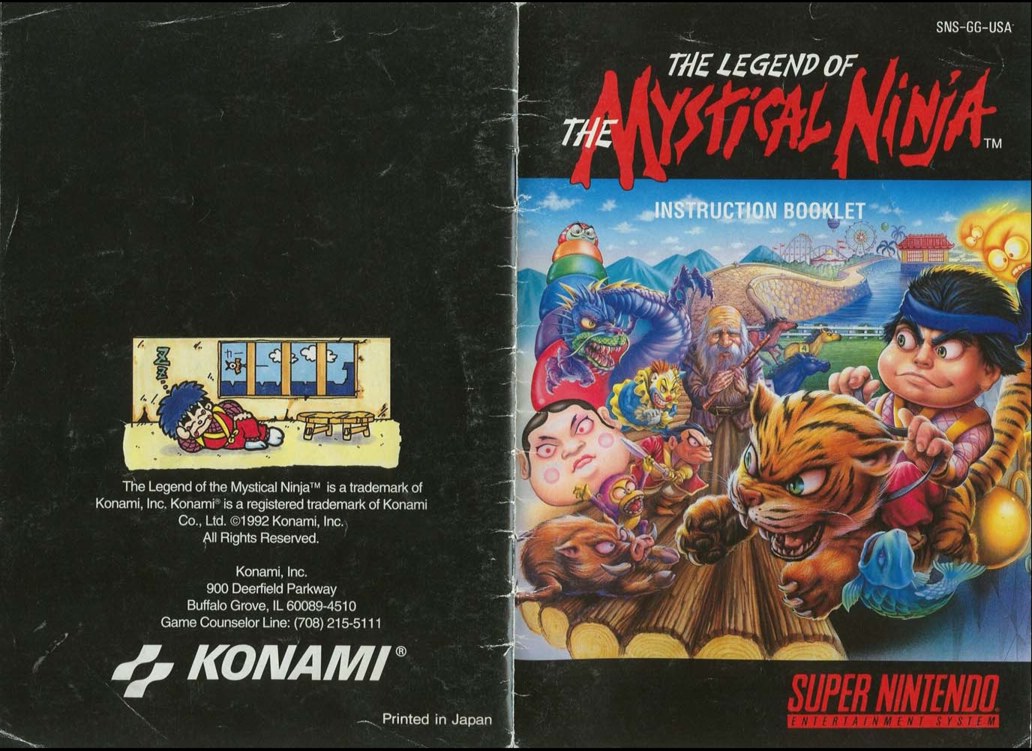 ^You don't need me to point out that this is the Western box art on the right, while everything else is in the manual is Japanese art. I probably don't dislike these sorts of Westernized cover art as most people, and if you had to use that art style then I think they didn't do a bad job with this one either. Not my preference, but eh whatever. Mainly I think Goemon looks a bit too odd for me. The enemies are decent, especially given that the game is so flexible with its own seriousness. The clown is the only character I wasn't immediately sure what it was meant to be, but I guess it is the NPC who wanders around the amusement park. ~~~ One thing that didn't escape my attention on the following pages is the mention of the "Dragonbeast" as the primary antagonist. This isn't mentioned in the game, so it seems made up for the Western manual like so much else. These pages go on to claim that the reason the friendly-looking townspeople attack you is because they are controlled by the "Silver Serpent". Whatever. I'm filing this under a "Mushroom citizens are inside the bricks" level of veracity. I also don't know about the "sinjin item" terminology to refer to your collective gear or "the Great Sukiyaki" as some important character who is giving you advice. I assume these are completely made up for the manual too. 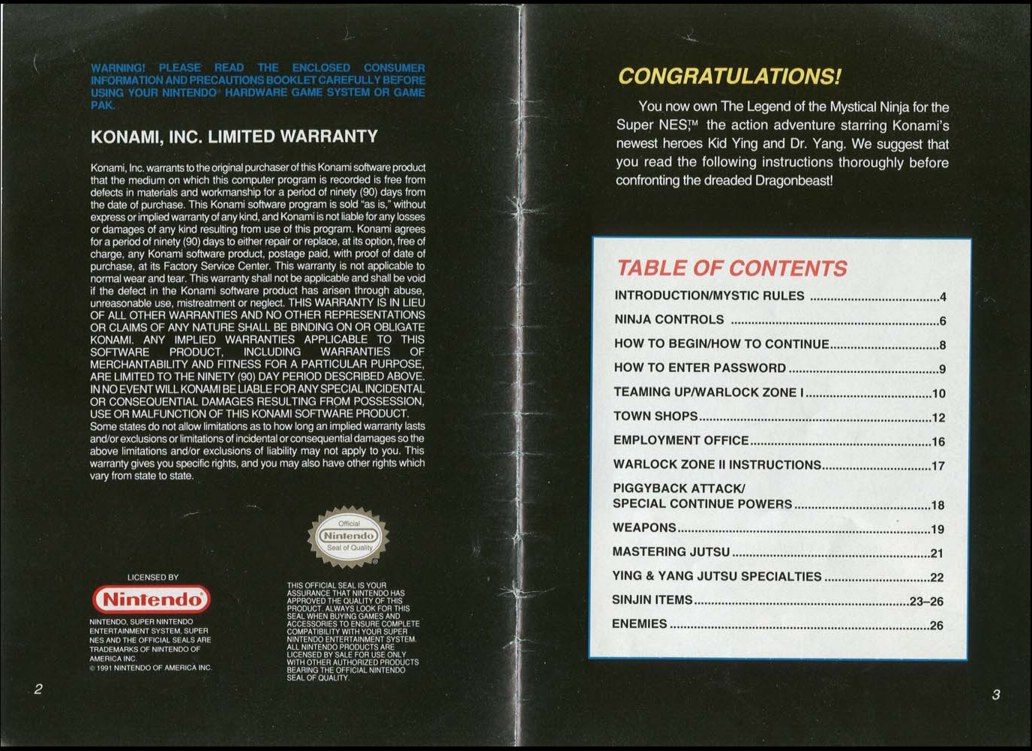 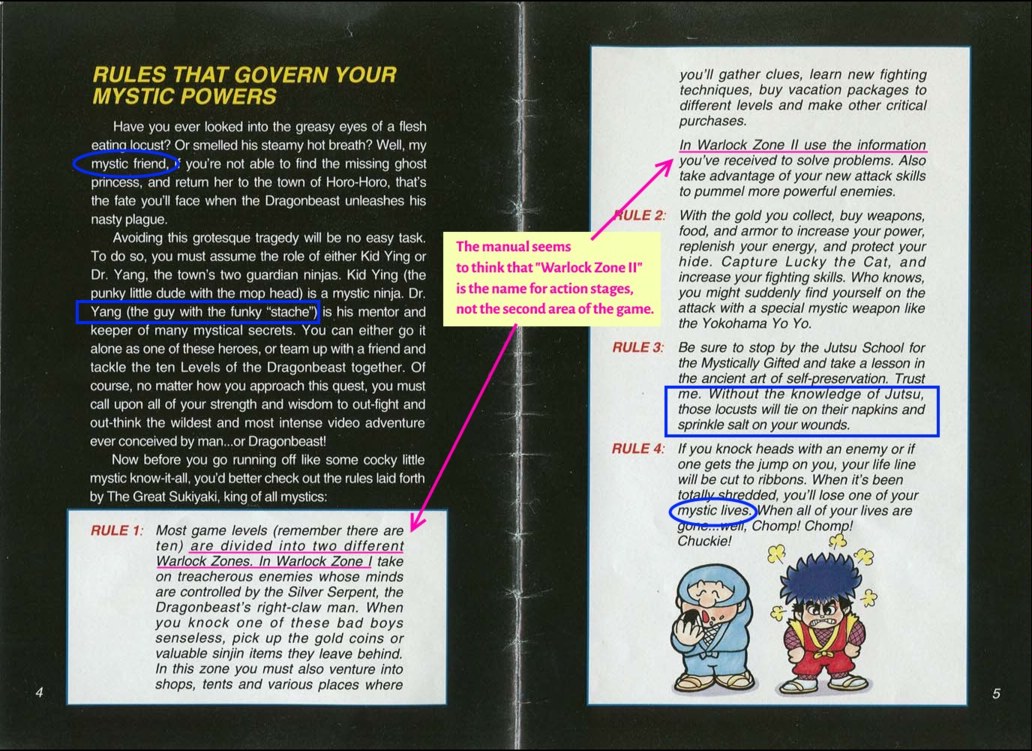 Everything special is "mystic" or "mystical". This game has a real bad case of what I call the "Link to the Past Syndrome", where one adjective is elevated above all others (magic hammer, magic mirror, magic bottle, magic cape, magic powder...) ~~~ 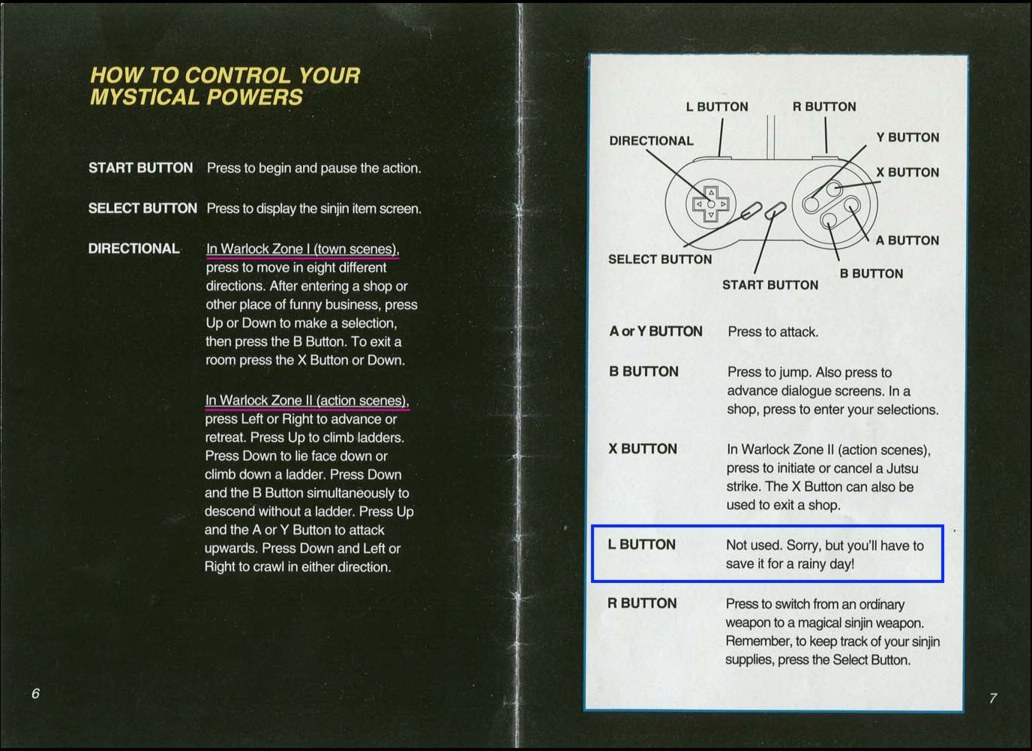 There's going to be a lot of corny text played for laughs and snark! I can't help but point out most of them here. When reading this manual, it's almost impossible not to imagine the person writing it and how they tried to make it fun to read through (and to be fair I think they were mostly successful. This was ahead of the curve for the era, perhaps?). 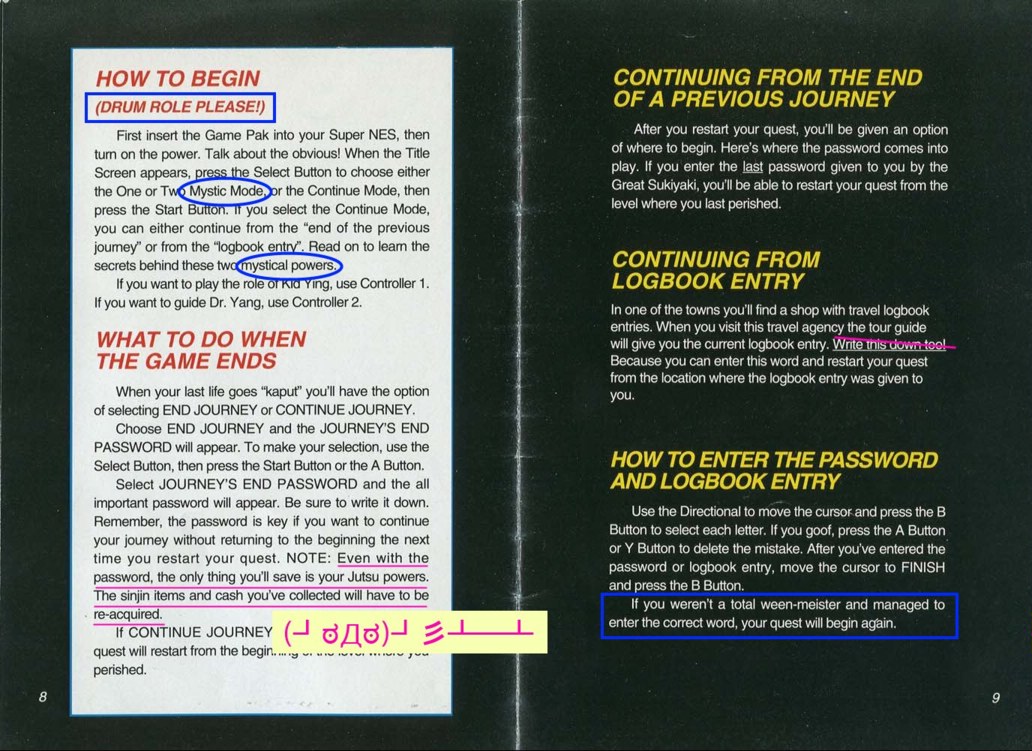 The password system in this game is a little complicated, and I don't always see it fully understood (including by myself sometimes!) First off, there's two types of passwords: When you get a game over and choose to 'end' (quit), you get a very short password that saves basically nothing other than the zone you were in. The second password is the one most people know about: the very long and complicated password you can ask for by visiting Diary Places. It's several lines long, and involves capitalizations, numbers, punctuation and a few symbols like hearts: 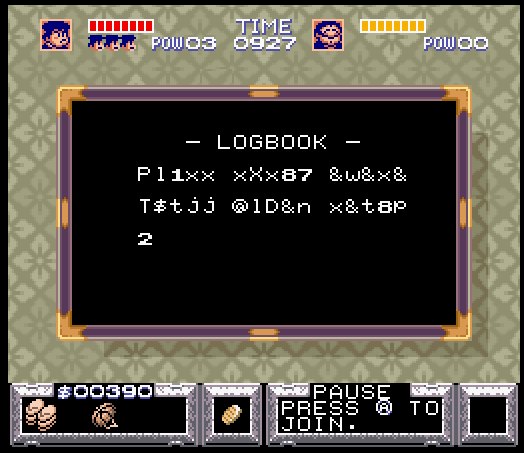 These long passwords do save everything you have (lives, gold, equipment, etc.), but honestly you don't need to write them down. Visiting the diary places also creates a save point that you can use freely, without inputting the password at all! Well, it is only "freely" usable in the sense that you need to intentionally lose all your lives to reload it, but it still works like a real save file (and restores all the lives you had before, of course). You can use these diary saves to replay minigames, play around with Judo powers, or simply restart if you screw up badly and wasted a lot of your equipment/gold/lives. That can be very important in the later stages! There is no save battery though, so theoretically the password itself is useful if you can't finish in one sitting (and don't have save states :P). This diary-based save file might delete itself when you enter a new zone as well, I'm not sure about that. ~~~ The manual now goes on to describe all the mini-games and specialty houses. If it wasn't obvious before, it's clear now that the writer was inventing their own names for everything: 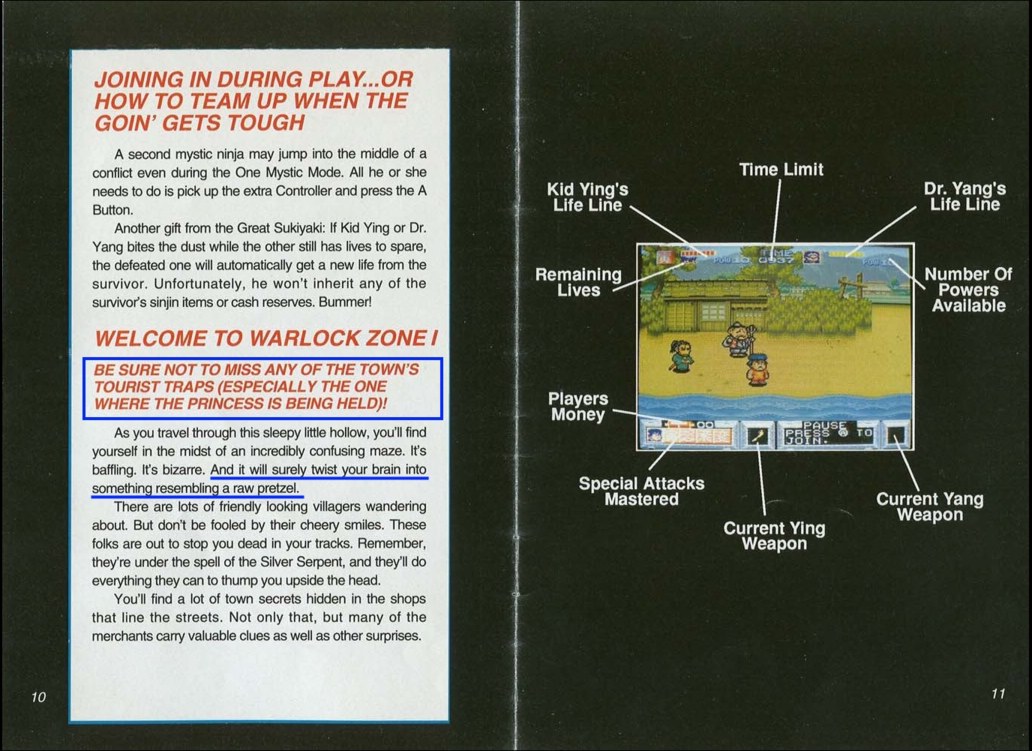 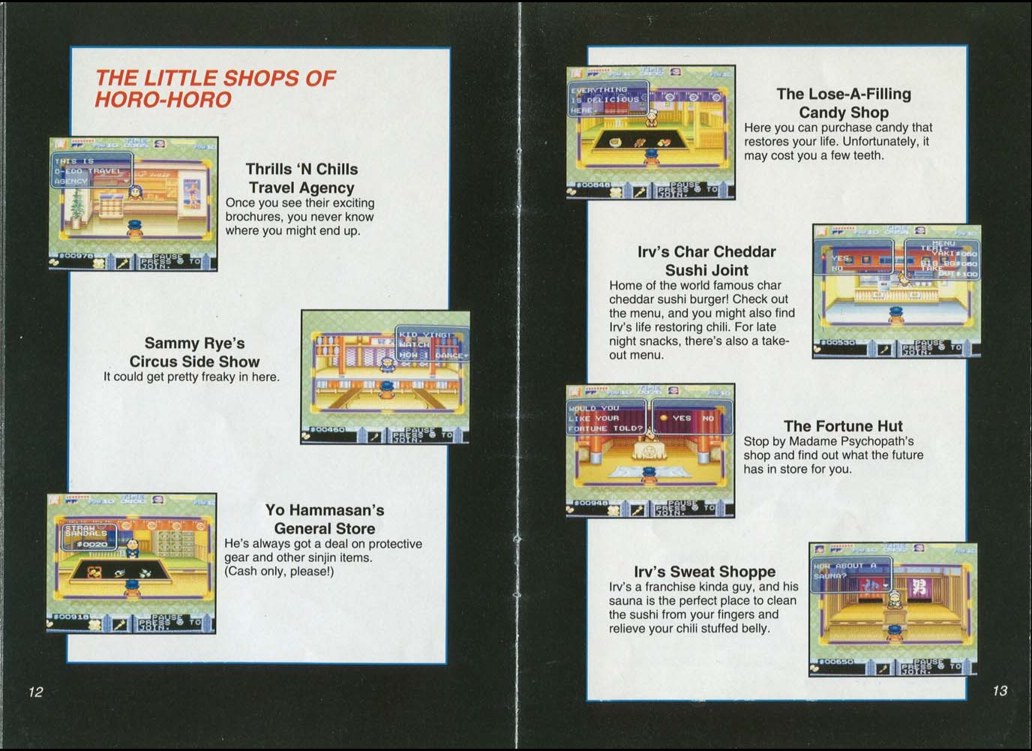 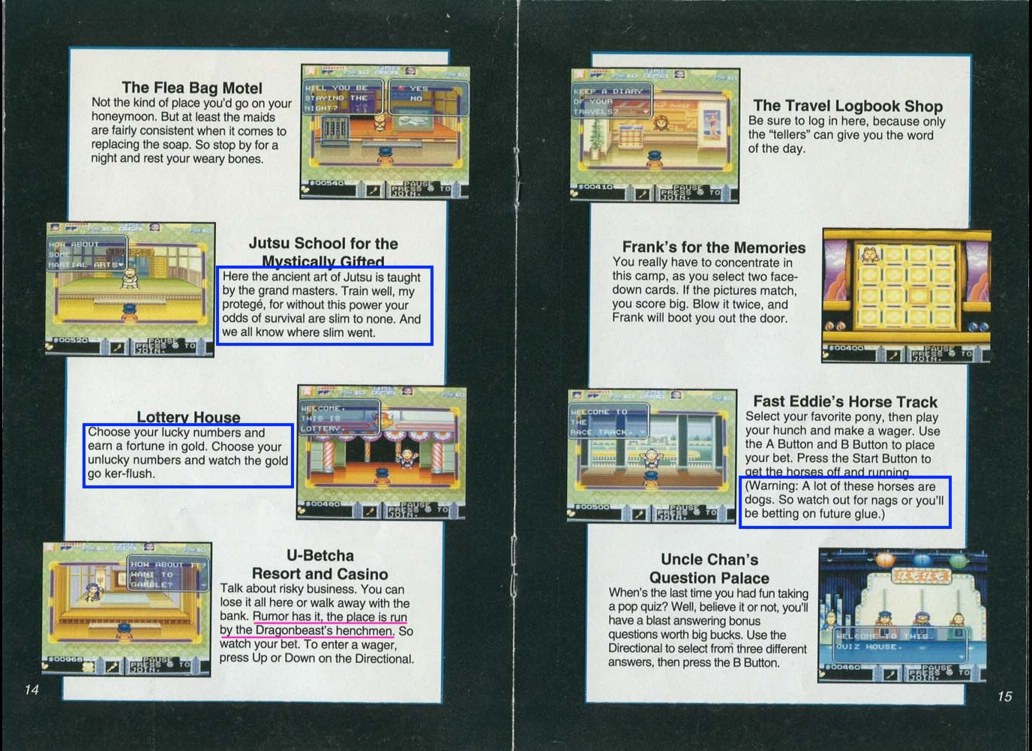 I don't care for the dice game (called a 'Casino' above), so this line seemed oddly fitting to me. ~~~ 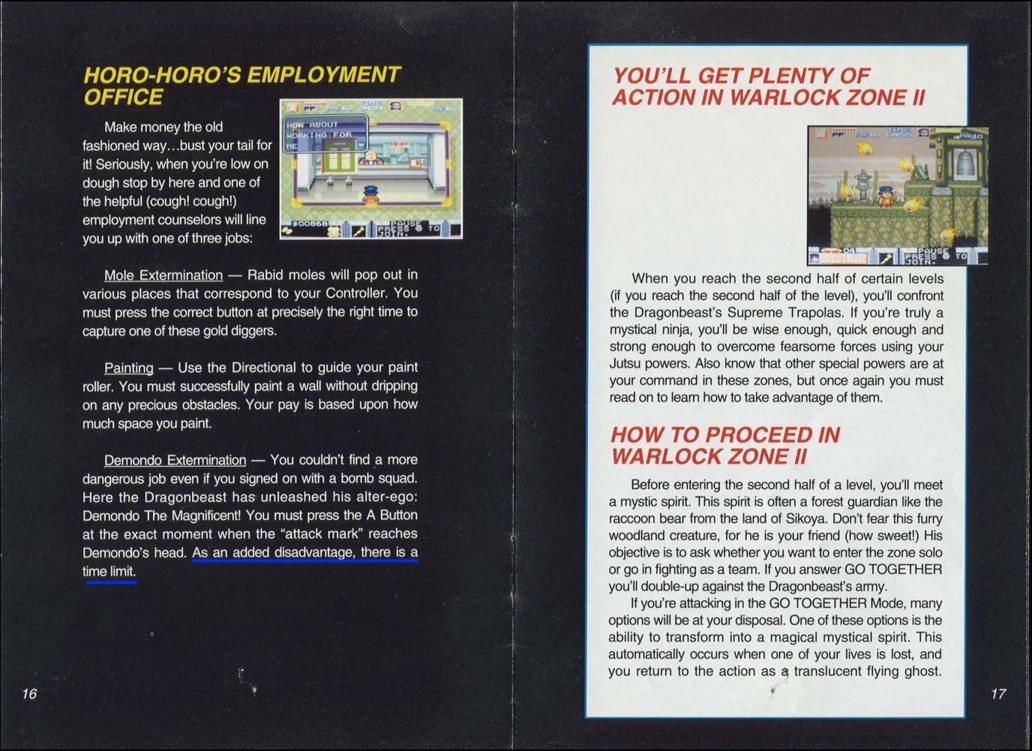 The goblin minigame ("Demondo", according to the manual) also ranks very low on the ordering of best minigames. I wonder if they are intentionally lampshading this fact or not. Curiously, they refer to the game shop as the "employment office". Am I wrong in thinking that this screenshot is from a different version of the game? I don't think it's ever called that. ~~~ Finally we get to a whole bunch of artwork and lists of items/powerups (yay!). This was always my favorite part of SNES manuals, and I don't think I'm alone. Side note: I'm awfully suspicious at these bomb and scroll items they list. I feel like there aren't 3 types of scroll pickups and there isn't a bomb pickup that grants 3 bombs, but whatever. 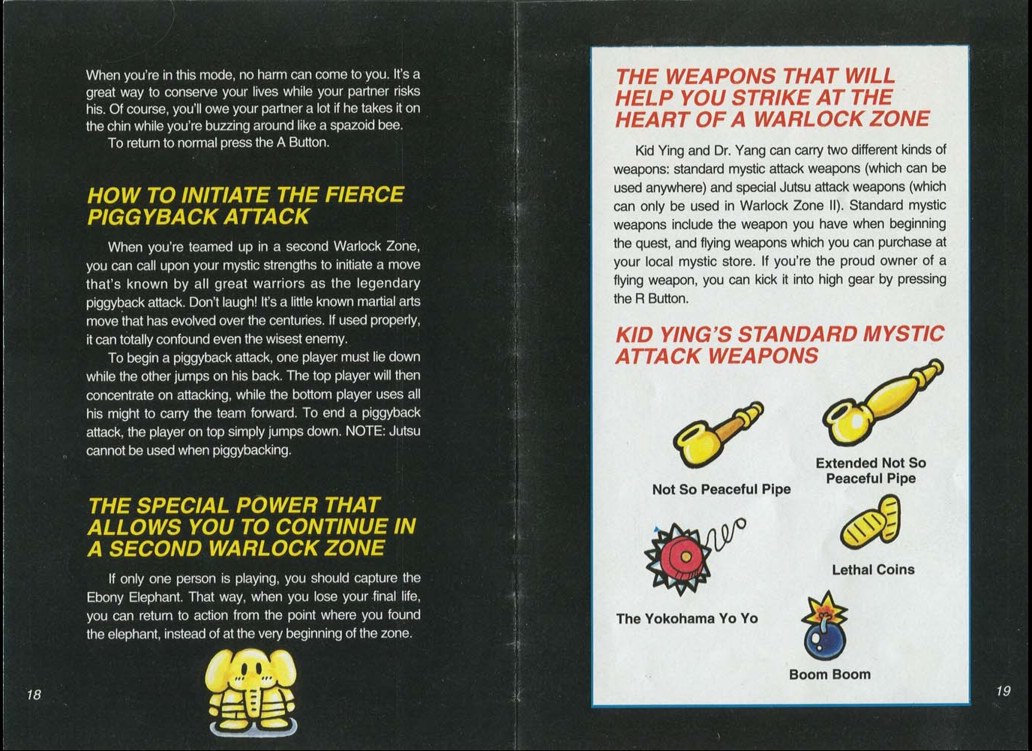 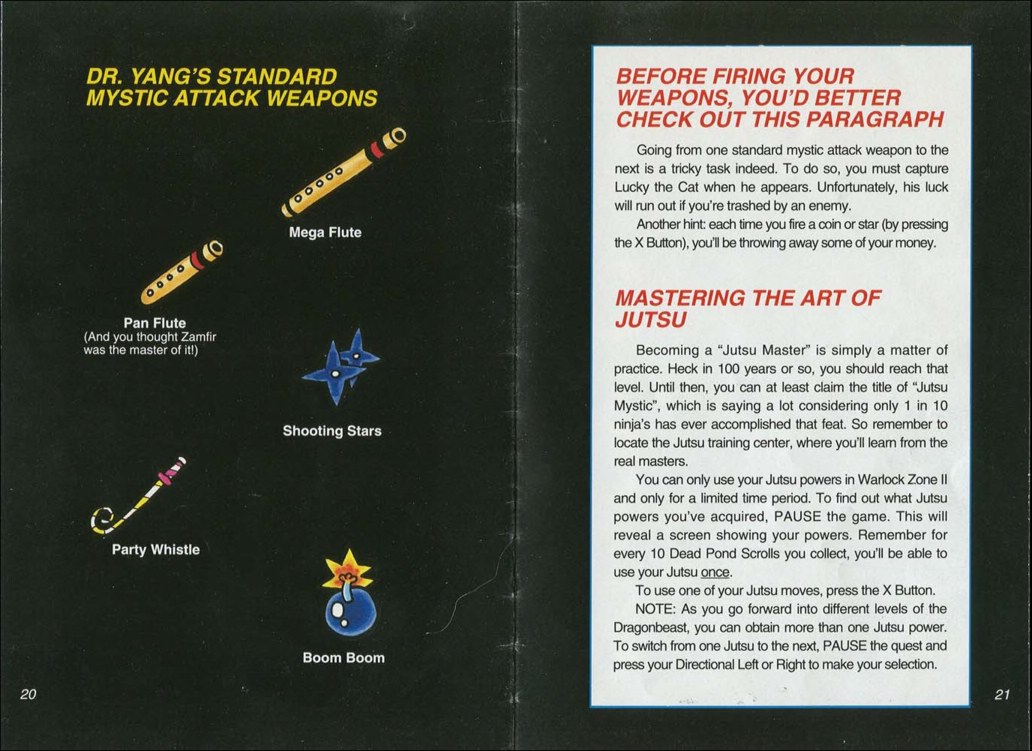 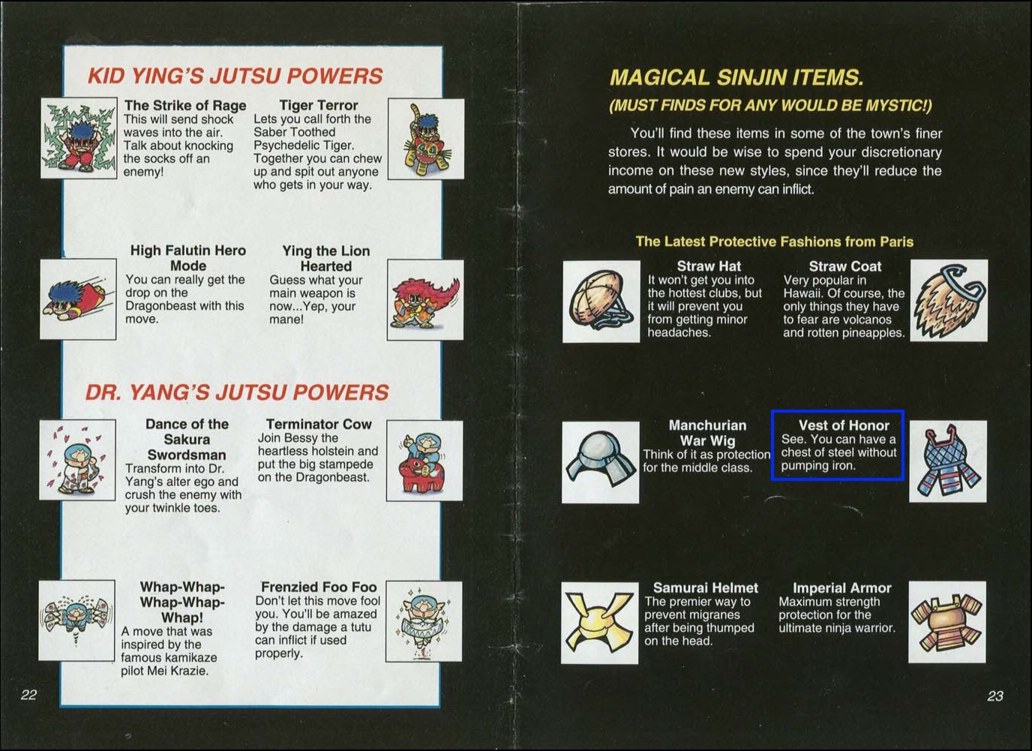 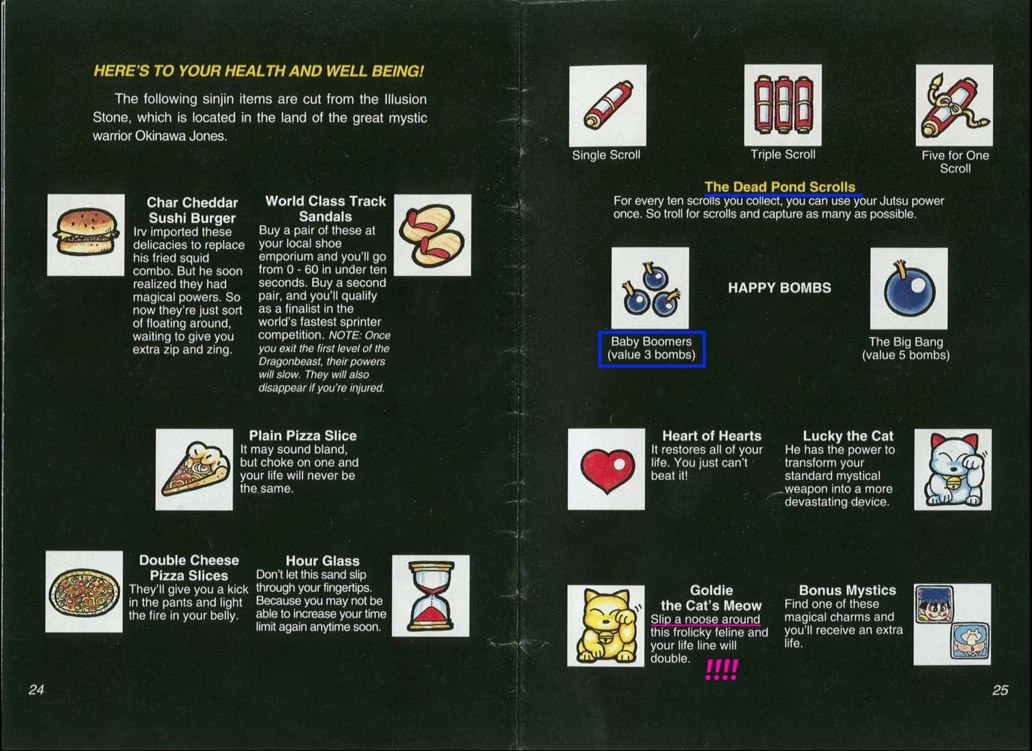 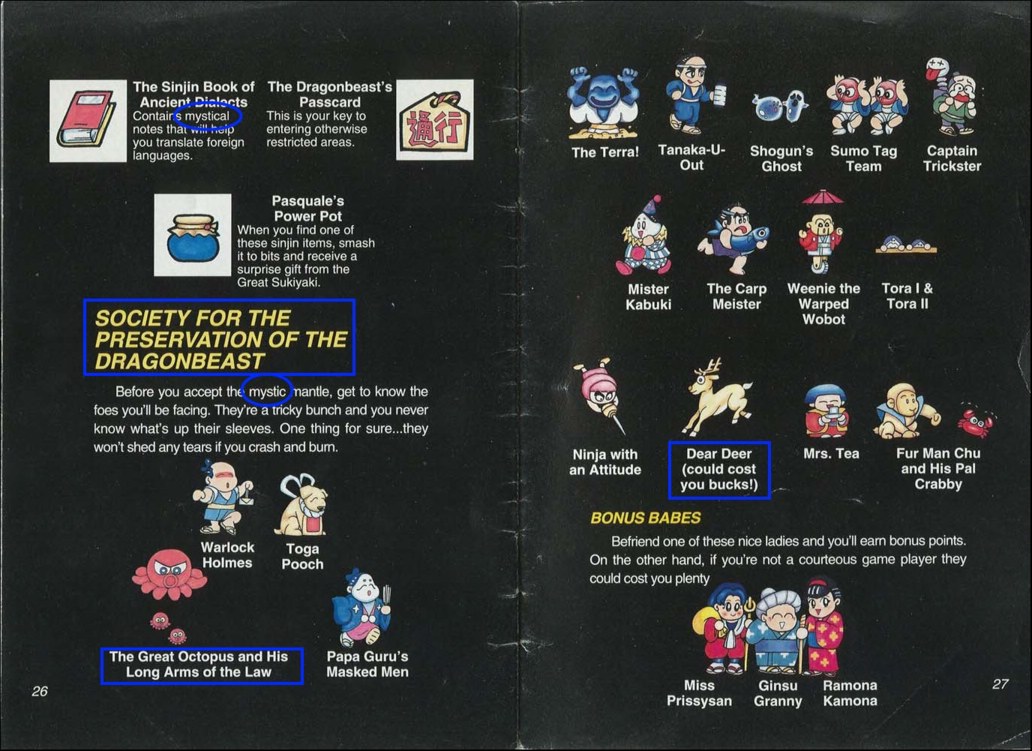 Last edited by dosboot; 11-30-2017 at 06:16 PM. |
|
#10
|
|||
|
|||
|
Seems pretty good considering the era. Could've been a whole lot worse. Odd that the writer misidentified Ebisumaru's tenugui as a mustache of all things.
|
|
#11
|
|||
|
|||
|
I was always sad that Goemon was always a third stringer in the grand hierarchy of video game characters, because all the games in this series that I have played have been really good and I'm not sure why they never took off. Culture shock? Are these games just too weird and silly?
|
|
#12
|
|||
|
|||
|
Episode 2:
https://www.youtube.com/watch?v=ta9wpG8z-RM Ads might appear on this video, you can watch the twitch upload if you want to get rid of them. Last edited by dosboot; 12-22-2017 at 09:08 PM. |
|
#13
|
||||
|
||||
|
Zone 3 is probably the most memorable level in the game, but I also think it one of the more interesting levels when it comes to cultural references. Namely it takes place on Awaji Island, and the developers built it around local points of interest.
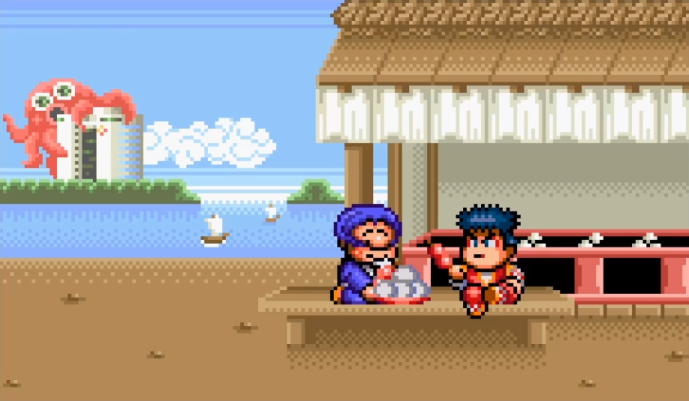 As mentioned in episode, you can see Konami's headquarters in the end screen for the zone. Konami's headquarters was on Awaji Island (until April 1993), and Mystical Ninja isn't even the only time they reference this building in their games: check out SD Snatcher! ~ The zone starts off with Goemon crossing a bridge with visible whirlpools below. This is the real life Onaruto Bridge and it's famous eddies. 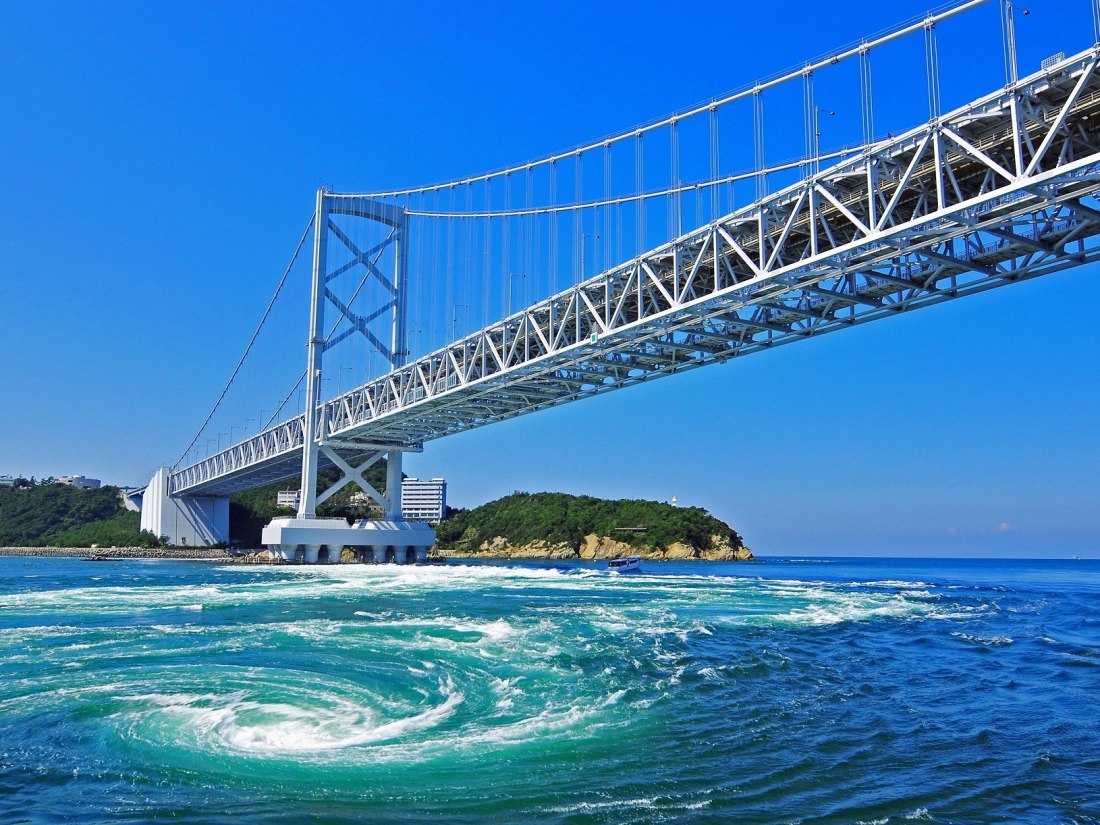 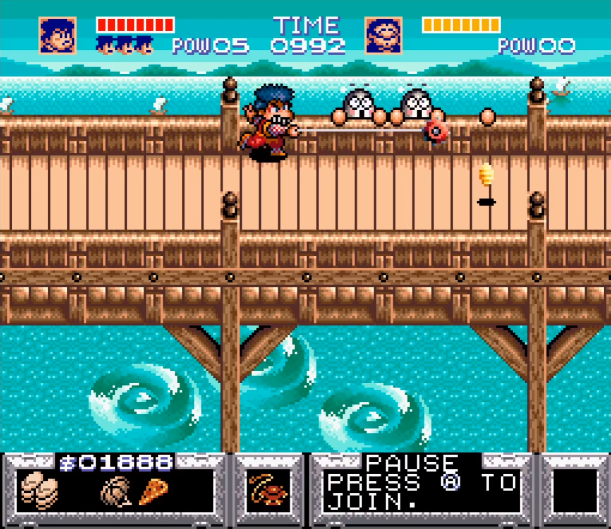 More on these whirlpools: Quote:
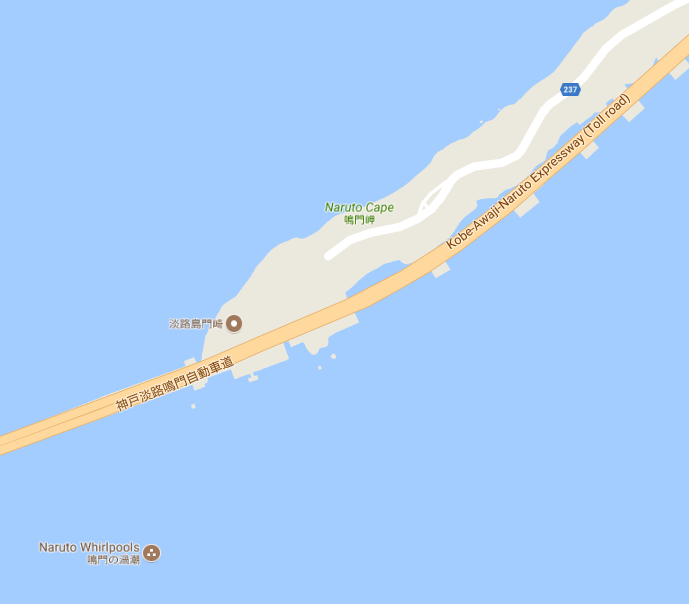 https://www.google.com/maps/place/Shikoku/@34.2418469,134.6576403,16.29z/data=!4m5!3m4!1s0x3551e76a6585fd45:0xd4602fd80d0ed 59d!8m2!3d33.7432238!4d133.6375314 ~ The level ends with another bridge, almost surely a reference to the Akashi Kaiyko bridge which links the north side of Awaji Island with Kobe. The Akashi Kaiyko bridge is in fact the longest suspension bridge in the world! In the level, it runs vertically from bottom to top, while the first bridge runs from left to right. This roughly matches the geography of Awaji island, with "up" in the game as "North". Both suspension bridges are depicted as wood and stone in the game though, perhaps more fitting of Goemon's world. 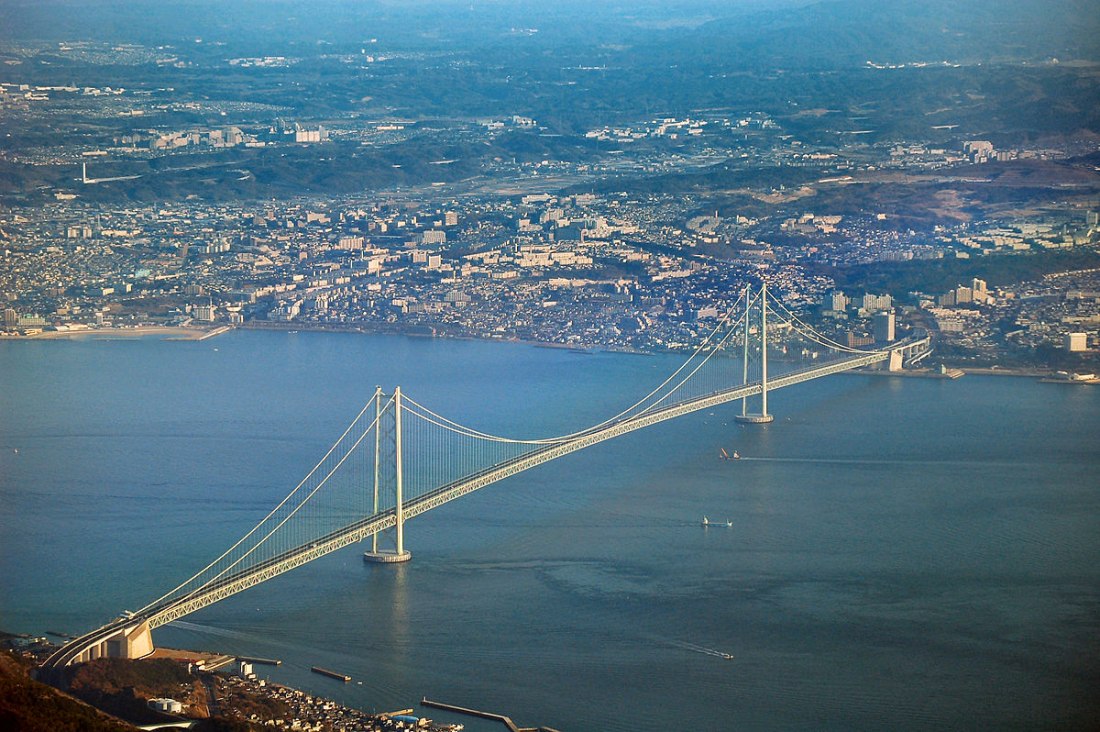 The Akashi Kaiyko bridge would not have been finished though at the time of release. Construction began in 1988 and it was still going through it's 10 year construction during the development of Legend of the Mystical Ninja (which you can guess was about 1990-1991). Nevertheless, this bridge was a momentous event. Quoting wikipedia, Quote:
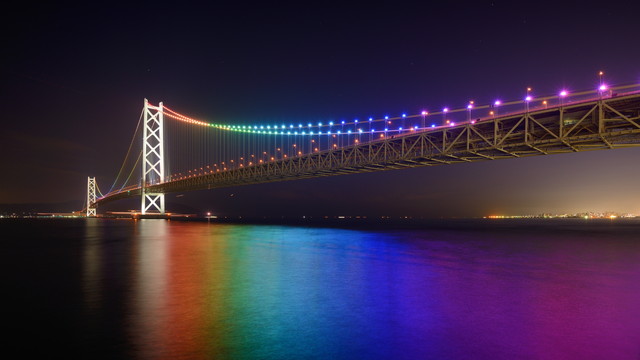 I think what makes these references interesting to me is now that I know what makes them special and now that I know that Konami's employees would have been residents here, I get a picture of local pride and eagerness to share their famous sights (and place of work :P). Another observation is that the Onaruto bridge was opened in 1985 and the Akashi Kaiyko bridge was opened in 1998. It seems particularly important that there are no other bridges to Awaji island that I can tell; they only used ferries before 1985. These bridges must have been an important generational event. Furthermore, you can deduce that not long before development of Mystical Ninja started, the developers would have being seeing all the news about the Akashi Kaikyo bridge beginning its construction. It suggests the possibility of a widespread sense of excitement on the island, which then made its way into the game like a little time capsule. I'm reminded of those stories you hear about the opening of the Golden Gate Bridge, how the city held all sorts of events surrounding it and how people got swept up in a craze for a while (one story I recall in particular is how people competed to be "the first" at doing X on the Golden Gate bridge: first person to walk across, first to ride a unicycle across, first to walk backwards across, etc...) ~ Enough about bridges, Zone 3 is also one big amusement park. Both of the websites I linked to in the first post failed to find any particular connection to real world locations on Awaji island (and, in the process, the technobuffalo article also seems to get its facts wrong about the bridges, but I digress). The first website offers the plausible suggestion that the Amusement park is a sideways reference to Konami itself, you know given they are an amusement company located on Awaji. However it seems to me that this level is in fact a giant reference to Awaji World Park Onokoro. 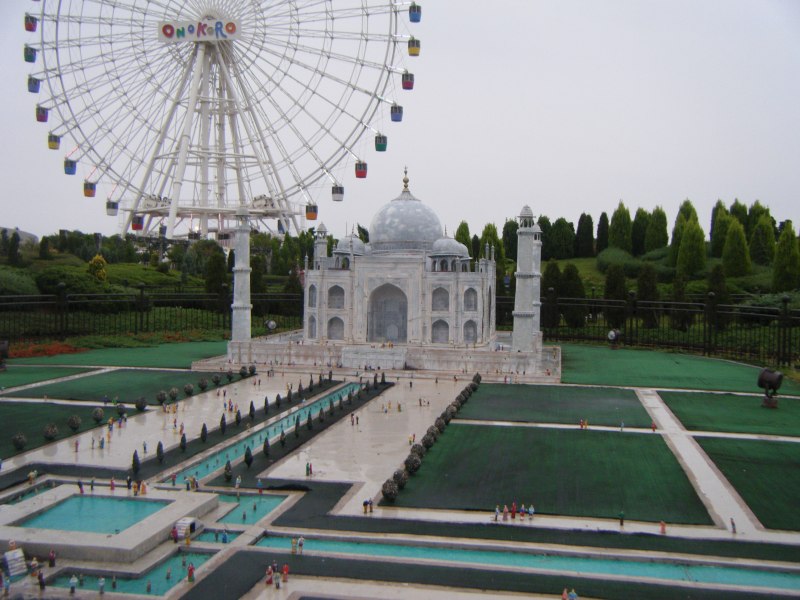 Awaji World Park Onokoro is an amusement park whose most unique attraction is a miniature world duplicating famous buildings worldwide in 1/25 of its original size, as well as many other family friendly activities and the usual types of rides. From Japan Hoppers: Quote:
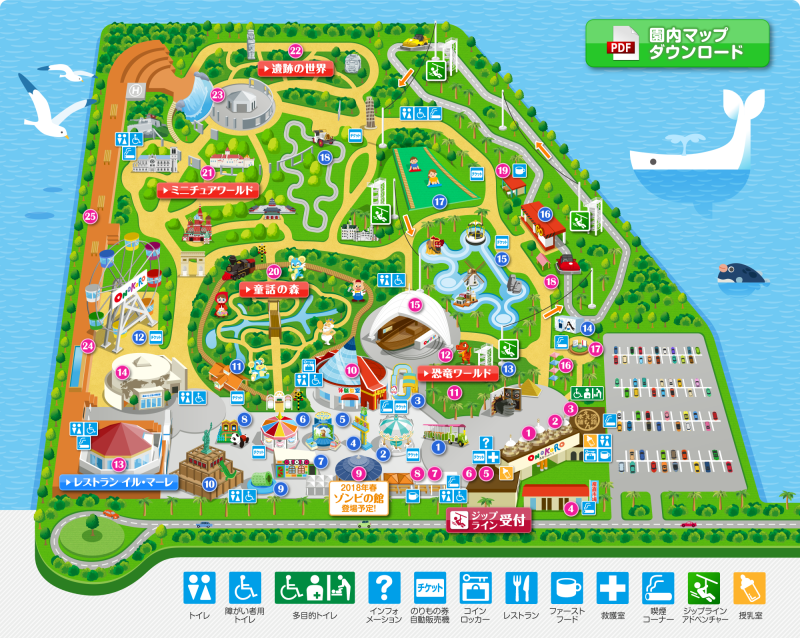 Now, it's very hard to find straightforward historical information on the English speaking internet, but reportedly this park was built towards the end of Japan's bubble economy. This seems flexible enough to come before the release date of Legend of the Mystical Ninja. (It also passes the google maps notoriety test and it gets mentioned on an otherwise sparse wikipedia entry about the city :P) Placing the arcade minigame here in zone 3 though? Yeah, that's probably a reference to Konami's location.  ~ Finally, going back to zone 2, when you exit the secret passage you get plopped in front of a bronze statue of Ryoma Sakamoto, who is a famous revolutionary samurai. 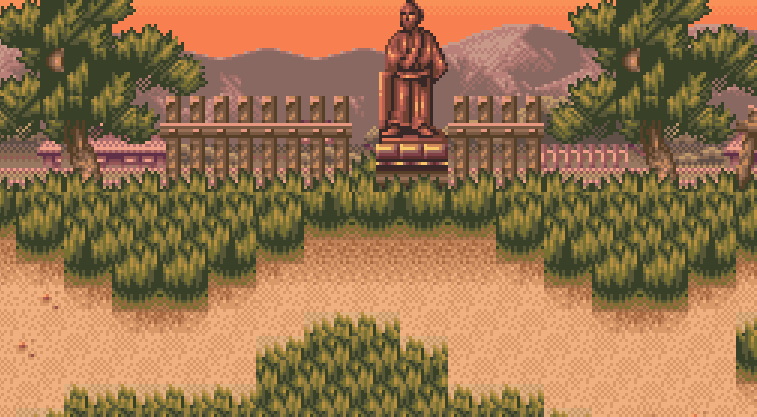 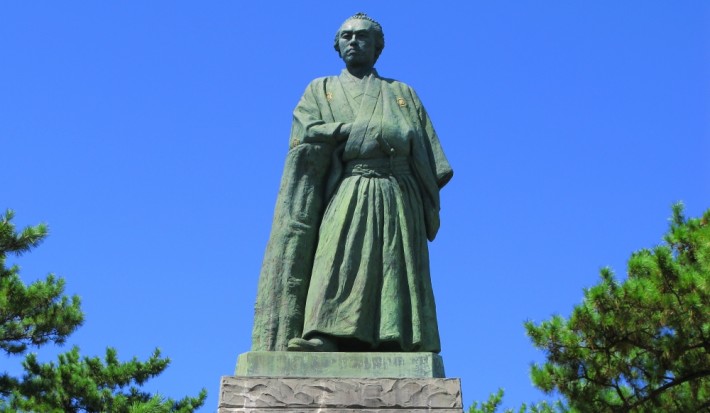 From wikipedia: Quote:
Now, before Roman Mars gets on my case: I did remember the mantra "Always Read the Plaque" but I couldn't find any transcriptions (or even pictures) online! Last edited by dosboot; 11-24-2017 at 05:19 PM. |
|
#14
|
|||
|
|||
|
I love this. It's so cool. Thanks for doing the research on this.
|
|
#15
|
|||
|
|||
|
Little late to the party but
RAMONA KAMONA I'm surprised and impressed the North American manual had the original art for enemies and NPCs, considering how the cover looks like your average localized airbrushed monstrosity. I also appreciate the real-life locale info, putting my efforts for Goemon 2 and 3 to shame. Last edited by SpoonyBardOL; 11-25-2017 at 11:33 AM. Reason: I am also a fan of 'Tanaka-U-Out' |
|
#16
|
|||
|
|||
|
Agreed. I played through this for the first time last year because it was one of those games I never beat in rental as a kid, and the most enoyable thing was getting to roam around Bizarro Japan, so getting more context for everything is delightful.
|
|
#17
|
|||
|
|||
|
The first time I played this one was with a friend, and we got destroyed right away. Before that I played LMN Starring Goemon on the N64, and I thoroughly loved it. I'm debating downloading the GBA one for Virtual Console. Does it have a similar difficulty to this one?
|
|
#18
|
|||
|
|||
|
Episode 3: Bonus Minigames at the Amusement Park
https://www.youtube.com/watch?v=Em65XdSZKuc Playing all the minigames was more fun than I expected! The arcade is still the best, but it's just fun to mess around with all of them. I'm also thinking playing the concentration game is the best way to make money. |
|
#19
|
|||
|
|||
|
I liked the game show a lot as there was basically no skill or chance involved. It's practically free money.
|
|
#20
|
|||
|
|||
|
It isn't? I've assumed it was some weird mustache for the past 25 or so years.
|
|
#21
|
|||
|
|||
|
Quote:
Another topic I was thinking about is how the Arcade costs money but doesn't offer any potential reward (unlike every other minigame and special stop). The value you get out of it is just playing it and so in that sense, it simulates real life. Now then, what about minigames in other video games? How often do they let you play something that costs money each time but where no rewards can be won? Zelda comes to mind when I think about fun minigames you'd play just for the heck of it, but they always seem to give you some rupees, consumables or upgrades. Kirby Super Star has stuff like the Gourmet Race, Quick Draw and Megaton punch. You don't get anything but you also don't pay anything, they are just accessed from the main menu. And in other Kirby games I think you get powers or 1ups. In Final Fantasy 4 there are a bunch of dancer shows that you pay to see and don't get anything out of, but they also aren't games either. Chrono Trigger's festival has games that you must pay to play, but you get Silver Points as rewards. Its surprisingly difficult to come up with these. I have a hazy picture of PS1/PS2 era jRPGs as the most likely candidates for these kind of minigames, but I can't say for certain which offer absolutely no reward. |
|
#22
|
|||
|
|||
|
Ocarina of Time lets you race the Running Man for no reward.
|
|
#23
|
|||
|
|||
|
Does he charge you money though? (I don't recall) I'm trying to think of examples where you have to pay each time, but where there is no potential reward (even a one-time upgrade).
|
|
#24
|
|||
|
|||
|
Super Mario RPG is the poster child for RPG minigames, at least on the SNES. The Moleville minecart game requires a payment and gives no direct reward as far as I remember, although you're likely to earn your admission and then some over the course of the game.
|
|
#25
|
|||
|
|||
|
Something else I came across regarding cultural references: The Awaji Burger:
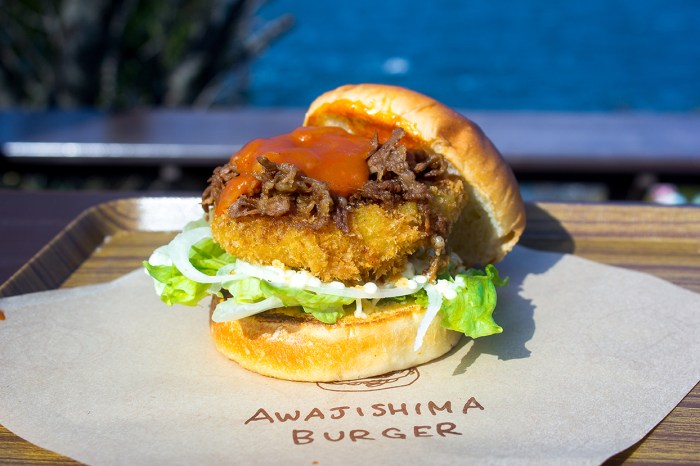 You can buy hamburgers in Zone 3, the only place that has a modern looking fast food shop. I know that the pizzas throughout the game were originally rice balls in the Japanese version, but I believe the hamburgers in Zone 3 are unchanged. They are supposed to be special to that one modern store, so it makes complete sense. It's also probably a local reference: From kansaiscene.com: Quote:
Last edited by dosboot; 12-01-2017 at 06:31 PM. |
|
#26
|
|||
|
|||
|
I am learning a lot from this thread!
|
|
#27
|
|||
|
|||
|
Episode 4: meeting up with Yae and a Ninja hideout sojourn
https://www.youtube.com/watch?v=Mc7-gqbEHG4 |
|
#28
|
|||
|
|||
|
Man, I can't decide what my favorite level of this game is either. So many good ones. I really like the music in Awaji and the rotating casino castle is great, but I love the festive atmosphere on Shikoku. The Ninja Castle in Iga is great too and I like the boss fight with Sasuke on the kite. Why is life so hard?
I really like how many times you get sent in the totally wrong direction in this game. Cobin sends you to take out the Otafu Army but they totally didn't do it, and the next act in Kyoto only because you the old man missed with his 'miracle machine.' Last edited by Solitayre; 12-08-2017 at 06:43 PM. |
|
#29
|
|||
|
|||
|
Yup. We also went to level 3 explicitly to chase the "horrible Otafu Army of Awaji Island", but then you get there and the NPC is like "Actually that's just the name of their holding company, the Otafu really operates out of a base way back on the mainland!"
The Ninja Castle also came to mind as a favorite level. It's similar to the Otafu level in lots of ways, but the town is kind of short and I always worry about those ninja bomb throwers destroying my hats. |
|
#30
|
|||
|
|||
|
The Buddhist Temple of zone 4's action stage does seem to be a direct reference to the Todaiji Temple in Nara, built in 752. This sounds like a really amazing place, but if you are like me you might have never heard about it for most of your life despite it being a world famous historical structure.
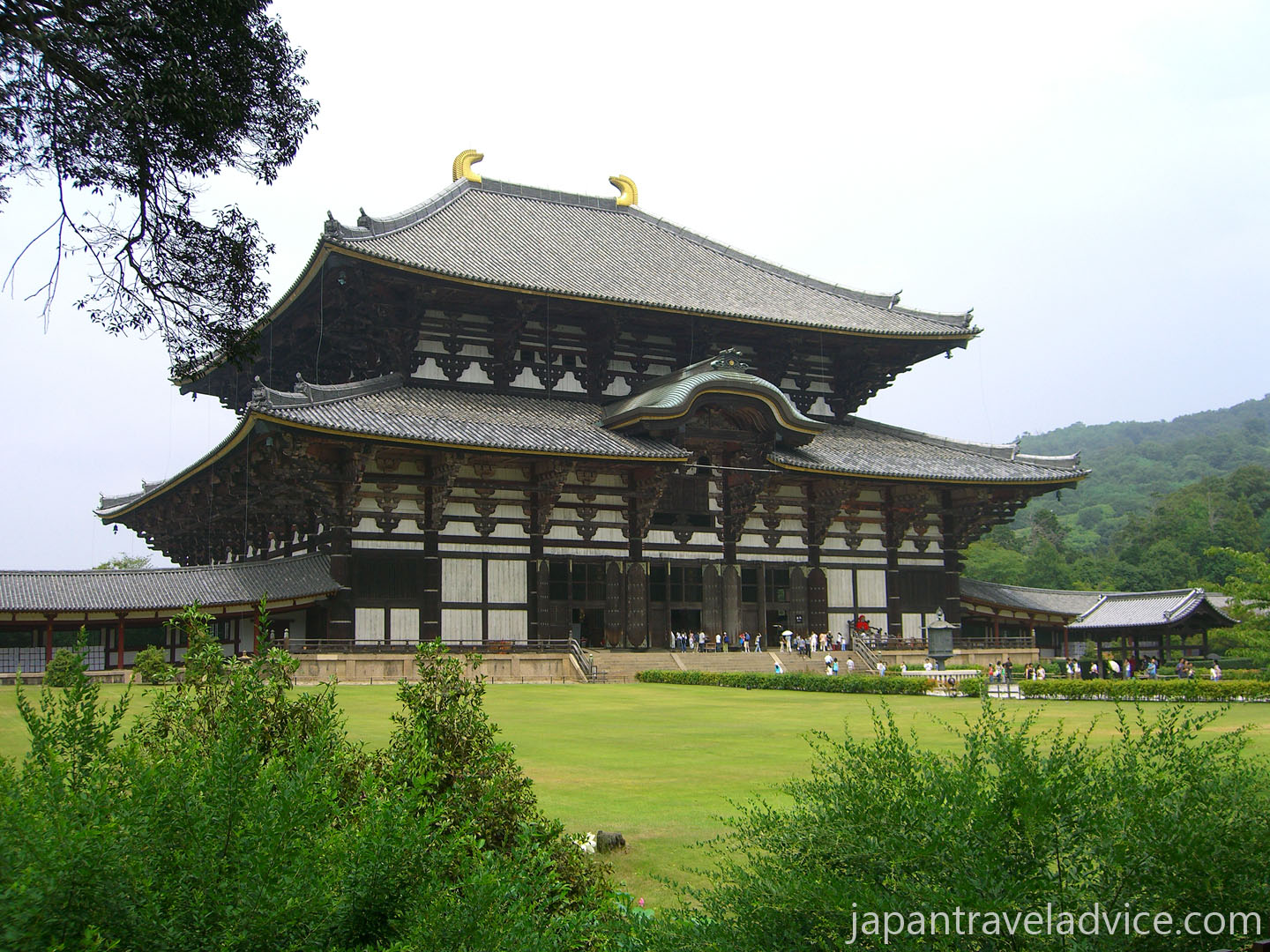 From Wikipedia: Quote:
  Which also explains the deer in this stage! The actual location is famous for it's large 15m bronze Buddha statue, but in the game you get several smaller ones. Still I think it's meant to be Todaiji or perhaps this game's fictional equivalent:  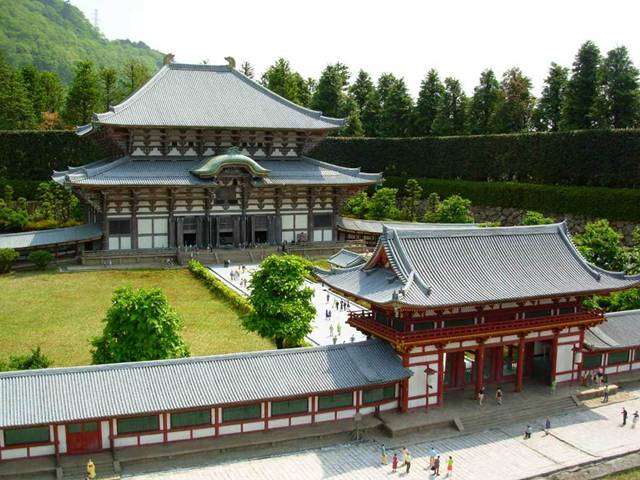 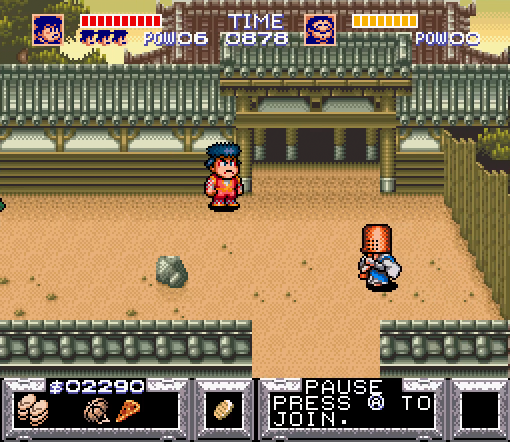 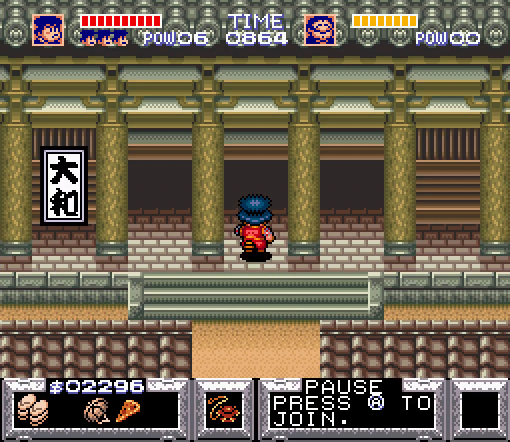 As you might expect, if you visit the Temple you can see many of Japan's oldest historical artifacts. I found it interesting that for a long time it was the largest wooden structure in the world (very long, like over 1200 years!). According to Japan Guide, the original main hall was even 50% bigger during those brief first 950 years. (The current largest wooden structure? The Meropol Parasol built in 2011.) ~ Zone 5 is the Ninja Castle, where we meet up with some of our ninja buddies in their tricky hideout. The game tells us this level is located in "the famous village of Iga" when we travel there. Once again, the game is referring to a real region of Japan. But in this case as with the later stages, it is moreso to fit the theme of the level without (I think) trying to exactly depict landmarks in that region. Iga is the name of a former province of Japan whose big claim to fame is being the birthplace of Ninjas (alongside the nearby Koka province). Today there is a Ninja museum called the Iga-ryu Ninja House for tourists to enjoy, which conveniently explains for us some important Ninja hideout knowledge: Quote:
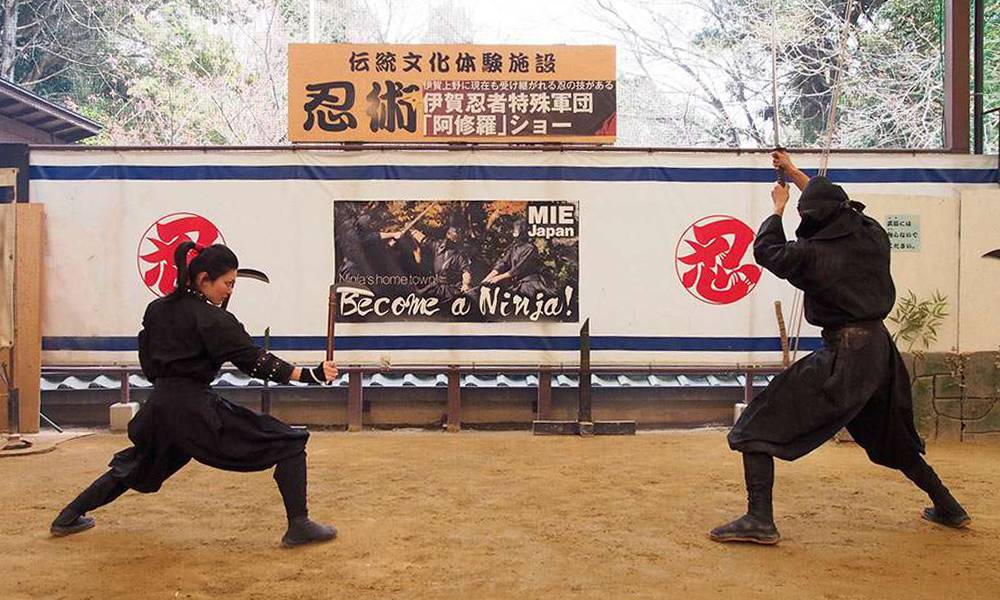 This Ninja museum even has live shows (trained performance fighting) and what sounds like a movie where their actors play out a ninja infiltration. Or you can throw ninja stars for 200 yen per pack of 5. Here's an article about the place with even more details. ~ Back to the game, I like some of the small background details we see in the hideout here: the lights coming through holes (possibly made during battle), and in general the scuff marks over all the wood beams: 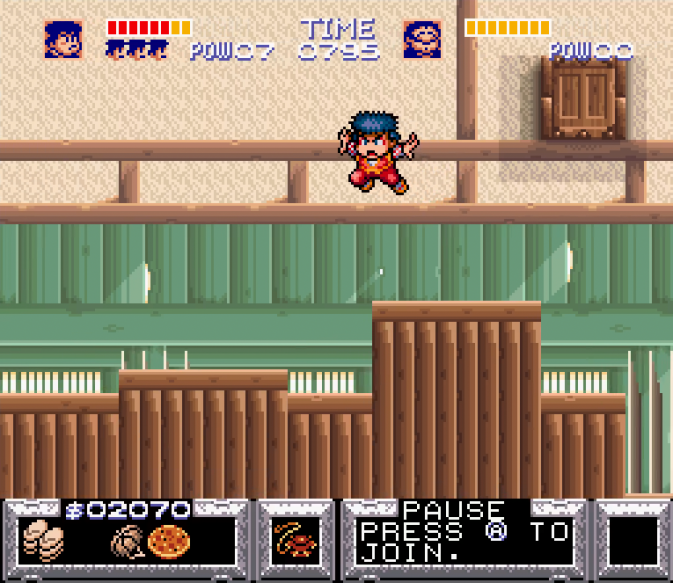 We encounter a lot of Goemon characters in these two levels. I will admit upfront that the wider Goemon series isn't as familiar to me as this game is. As such I only feel comfortable sticking with the basics: First and foremost is our friend and fellow ninja, Yae. She was rescued in level 4 from the Otafu Army (who "are known to kidnap women", although there's also a clear plot explanation later as well). She's the lead female character in Goemon, and the more responsible one compared to Goemon and Ebisamaru. Sasuke is the badass who fights us from the kite and the wise old man who provides us with cannon travel is "Wise Old Man". He's also known as Monoshiri Ojisan, which is literally "wise old man" (ha!). You obviously don't get a great sense of these characters though in this game, but Monoshiri is an inventor and Sasuke is a combat robot created by him. 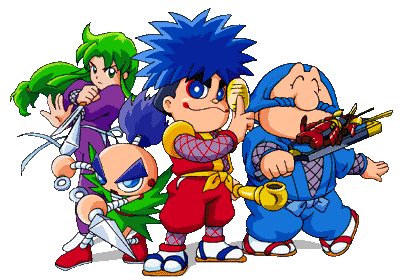 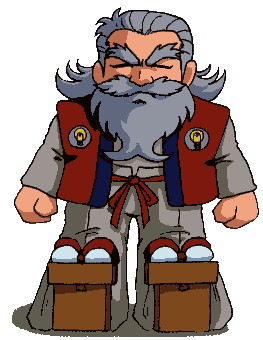
|
